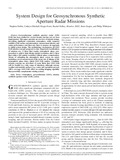- CERES Home
- →
- School of Engineering (SoE)
- →
- Staff publications (SoE)
- →
- View Item
JavaScript is disabled for your browser. Some features of this site may not work without it.
| dc.contributor.author | Hobbs, Stephen | |
| dc.contributor.author | Mitchell, C. | |
| dc.contributor.author | Forte, B. | |
| dc.contributor.author | Holley, R. | |
| dc.contributor.author | Snapir, Boris | |
| dc.contributor.author | Whittaker, P. | |
| dc.date.accessioned | 2015-11-17T10:42:04Z | |
| dc.date.available | 2015-11-17T10:42:04Z | |
| dc.date.issued | 2014-06-12 | |
| dc.identifier.citation | Hobbs S, Mitchell C, Forte B, et al., (2014). System design for geosynchronous synthetic aperture radar missions. IEEE Transactions on Geoscience and Remote Sensing, Volume 52, Issue 12, December 2014, pp. 7750-7763 | en_UK |
| dc.identifier.issn | 0196-2892 | |
| dc.identifier.uri | http://dx.doi.org/10.1109/TGRS.2014.2318171 | |
| dc.identifier.uri | http://dspace.lib.cranfield.ac.uk/handle/1826/9591 | |
| dc.description.abstract | Geosynchronous synthetic aperture radar (GEO SAR) has been studied for several decades but has not yet been implemented. This paper provides an overview of mission design, describing significant constraints (atmosphere, orbit, temporal stability of the surface and atmosphere, measurement physics, and radar performance) and then uses these to propose an approach to initial system design. The methodology encompasses all GEO SAR mission concepts proposed to date. Important classifications of missions are: 1) those that require atmospheric phase compensation to achieve their design spatial resolution; and 2) those that achieve full spatial resolution without phase compensation. Means of estimating the atmospheric phase screen are noted, including a novel measurement of the mean rate of change of the atmospheric phase delay, which GEO SAR enables. Candidate mission concepts are described. It seems likely that GEO SAR will be feasible in a wide range of situations, although extreme weather and unstable surfaces (e.g., water, tall vegetation) prevent 100% coverage. GEO SAR offers an exciting imaging capability that powerfully complements existing systems. | en_UK |
| dc.language.iso | en | en_UK |
| dc.publisher | Institute of Electrical and Electronics Engineers | en_UK |
| dc.rights | Attribution-Non-Commercial 3.0 Unported (CC BY-NC 3.0) You are free to: Share — copy and redistribute the material in any medium or format, Adapt — remix, transform, and build upon the material. The licensor cannot revoke these freedoms as long as you follow the license terms. Under the following terms: Attribution — You must give appropriate credit, provide a link to the license, and indicate if changes were made. You may do so in any reasonable manner, but not in any way that suggests the licensor endorses you or your use. Information: Non-Commercial — You may not use the material for commercial purposes. No additional restrictions — You may not apply legal terms or technological measures that legally restrict others from doing anything the license permits. | en_UK |
| dc.rights | (c) 2016 IEEE. Personal use of this material is permitted. Permission from IEEE must be obtained for all other users, including reprinting/ republishing this material for advertising or promotional purposes, creating new collective works for resale or redistribution to servers or lists, or reuse of any copyrighted components of this work in other works. | en_UK |
| dc.subject | Atmosphere | en_UK |
| dc.subject | geosynchronous (GEO) | en_UK |
| dc.subject | mission | en_UK |
| dc.subject | synthetic aperture radar (SAR) | en_UK |
| dc.subject | system | en_UK |
| dc.title | System design for geosynchronous synthetic aperture radar missions | en_UK |
| dc.type | Article | en_UK |
| dc.identifier.cris | 3321214 |
Files in this item
This item appears in the following Collection(s)
-
Staff publications (SoE) [603]
